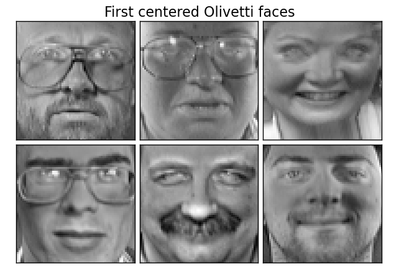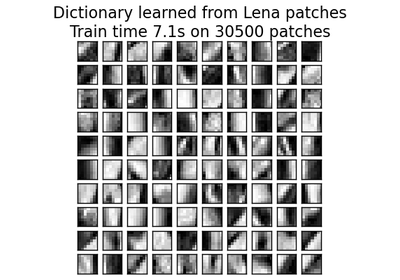sklearn.decomposition.MiniBatchDictionaryLearning¶
- class sklearn.decomposition.MiniBatchDictionaryLearning(n_components=None, alpha=1, n_iter=1000, fit_algorithm='lars', n_jobs=1, batch_size=3, shuffle=True, dict_init=None, transform_algorithm='omp', transform_n_nonzero_coefs=None, transform_alpha=None, verbose=False, split_sign=False, random_state=None)[source]¶
Mini-batch dictionary learning
Finds a dictionary (a set of atoms) that can best be used to represent data using a sparse code.
Solves the optimization problem:
(U^*,V^*) = argmin 0.5 || Y - U V ||_2^2 + alpha * || U ||_1 (U,V) with || V_k ||_2 = 1 for all 0 <= k < n_componentsRead more in the User Guide.
Parameters: n_components : int,
number of dictionary elements to extract
alpha : float,
sparsity controlling parameter
n_iter : int,
total number of iterations to perform
fit_algorithm : {‘lars’, ‘cd’}
lars: uses the least angle regression method to solve the lasso problem (linear_model.lars_path) cd: uses the coordinate descent method to compute the Lasso solution (linear_model.Lasso). Lars will be faster if the estimated components are sparse.
transform_algorithm : {‘lasso_lars’, ‘lasso_cd’, ‘lars’, ‘omp’, ‘threshold’}
Algorithm used to transform the data. lars: uses the least angle regression method (linear_model.lars_path) lasso_lars: uses Lars to compute the Lasso solution lasso_cd: uses the coordinate descent method to compute the Lasso solution (linear_model.Lasso). lasso_lars will be faster if the estimated components are sparse. omp: uses orthogonal matching pursuit to estimate the sparse solution threshold: squashes to zero all coefficients less than alpha from the projection dictionary * X’
transform_n_nonzero_coefs : int, 0.1 * n_features by default
Number of nonzero coefficients to target in each column of the solution. This is only used by algorithm=’lars’ and algorithm=’omp’ and is overridden by alpha in the omp case.
transform_alpha : float, 1. by default
If algorithm=’lasso_lars’ or algorithm=’lasso_cd’, alpha is the penalty applied to the L1 norm. If algorithm=’threshold’, alpha is the absolute value of the threshold below which coefficients will be squashed to zero. If algorithm=’omp’, alpha is the tolerance parameter: the value of the reconstruction error targeted. In this case, it overrides n_nonzero_coefs.
split_sign : bool, False by default
Whether to split the sparse feature vector into the concatenation of its negative part and its positive part. This can improve the performance of downstream classifiers.
n_jobs : int,
number of parallel jobs to run
dict_init : array of shape (n_components, n_features),
initial value of the dictionary for warm restart scenarios
verbose : :
degree of verbosity of the printed output
batch_size : int,
number of samples in each mini-batch
shuffle : bool,
whether to shuffle the samples before forming batches
random_state : int or RandomState
Pseudo number generator state used for random sampling.
Attributes: components_ : array, [n_components, n_features]
components extracted from the data
inner_stats_ : tuple of (A, B) ndarrays
Internal sufficient statistics that are kept by the algorithm. Keeping them is useful in online settings, to avoid loosing the history of the evolution, but they shouldn’t have any use for the end user. A (n_components, n_components) is the dictionary covariance matrix. B (n_features, n_components) is the data approximation matrix
n_iter_ : int
Number of iterations run.
See also
SparseCoder, DictionaryLearning, SparsePCA, MiniBatchSparsePCA
Notes
References:
J. Mairal, F. Bach, J. Ponce, G. Sapiro, 2009: Online dictionary learning for sparse coding (http://www.di.ens.fr/sierra/pdfs/icml09.pdf)
Methods
fit(X[, y]) Fit the model from data in X. fit_transform(X[, y]) Fit to data, then transform it. get_params([deep]) Get parameters for this estimator. partial_fit(X[, y, iter_offset]) Updates the model using the data in X as a mini-batch. set_params(**params) Set the parameters of this estimator. transform(X[, y]) Encode the data as a sparse combination of the dictionary atoms. - __init__(n_components=None, alpha=1, n_iter=1000, fit_algorithm='lars', n_jobs=1, batch_size=3, shuffle=True, dict_init=None, transform_algorithm='omp', transform_n_nonzero_coefs=None, transform_alpha=None, verbose=False, split_sign=False, random_state=None)[source]¶
- fit(X, y=None)[source]¶
Fit the model from data in X.
Parameters: X: array-like, shape (n_samples, n_features) :
Training vector, where n_samples in the number of samples and n_features is the number of features.
Returns: self : object
Returns the instance itself.
- fit_transform(X, y=None, **fit_params)[source]¶
Fit to data, then transform it.
Fits transformer to X and y with optional parameters fit_params and returns a transformed version of X.
Parameters: X : numpy array of shape [n_samples, n_features]
Training set.
y : numpy array of shape [n_samples]
Target values.
Returns: X_new : numpy array of shape [n_samples, n_features_new]
Transformed array.
- get_params(deep=True)[source]¶
Get parameters for this estimator.
Parameters: deep: boolean, optional :
If True, will return the parameters for this estimator and contained subobjects that are estimators.
Returns: params : mapping of string to any
Parameter names mapped to their values.
- partial_fit(X, y=None, iter_offset=None)[source]¶
Updates the model using the data in X as a mini-batch.
Parameters: X: array-like, shape (n_samples, n_features) :
Training vector, where n_samples in the number of samples and n_features is the number of features.
iter_offset: integer, optional :
The number of iteration on data batches that has been performed before this call to partial_fit. This is optional: if no number is passed, the memory of the object is used.
Returns: self : object
Returns the instance itself.
- set_params(**params)[source]¶
Set the parameters of this estimator.
The method works on simple estimators as well as on nested objects (such as pipelines). The former have parameters of the form <component>__<parameter> so that it’s possible to update each component of a nested object.
Returns: self :
- transform(X, y=None)[source]¶
Encode the data as a sparse combination of the dictionary atoms.
Coding method is determined by the object parameter transform_algorithm.
Parameters: X : array of shape (n_samples, n_features)
Test data to be transformed, must have the same number of features as the data used to train the model.
Returns: X_new : array, shape (n_samples, n_components)
Transformed data



